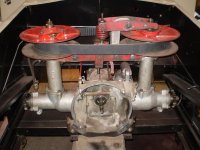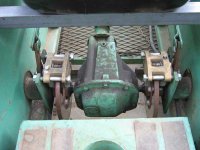berg
Member
Two drive train questions...
I am puzzled about the operation of a variator and how they function.
Can somebody give me a lesson on the physics behind it's function?
Seems to be reliable and simple. but looks like alot of stress would be put on those cast upright thingamajigs.
I know how the hydrostaics operate but why not use a system like this in the second pic? Seems like it would be the most simple to operate, no belts or fluid etc. What am I missing?.
I saw one cat with 2 dana 60's for each track as well. Why don't more units use an axle . Is there too much power lost to a pinion geared setup?
Just curious to know why things have evolved the way they have in the drive train dept...
I don't own a cat yet.. still looking. Thought I had a ST4 Located and went to the fellow's home only to find it was a Kristi. I did
not have a camera but will post a pic soon. The owner was not home.
I am puzzled about the operation of a variator and how they function.
Can somebody give me a lesson on the physics behind it's function?
Seems to be reliable and simple. but looks like alot of stress would be put on those cast upright thingamajigs.
I know how the hydrostaics operate but why not use a system like this in the second pic? Seems like it would be the most simple to operate, no belts or fluid etc. What am I missing?.
I saw one cat with 2 dana 60's for each track as well. Why don't more units use an axle . Is there too much power lost to a pinion geared setup?
Just curious to know why things have evolved the way they have in the drive train dept...
I don't own a cat yet.. still looking. Thought I had a ST4 Located and went to the fellow's home only to find it was a Kristi. I did
not have a camera but will post a pic soon. The owner was not home.
Attachments
Last edited:


